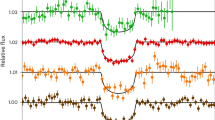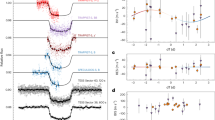Abstract
The remnant of the supernova explosion of AD 1006 (the brightest in recorded history) has a shell-like appearance at both radio and X-ray wavelengths. Einstein X-ray observations by Pye et al.1 show a soft (photon energy ε ≲ ¼ keV) filled interior surrounded by a harder (ε ≳ 1 keV) unresolved ring of emission of radius ∼15 arc min. Superficially it appears to be similar to most supernova remnants for which many studies have shown that the X-ray emission is thermal radiation from gas shock-heated by high-velocity ejecta. The spectrum2 of parts of the edge of the remnant in the range 0.75 ≲ ε ≲ 10 keV shows, however, no evidence for line emission. The spectral shape is consistent with a power-law perhaps due to a non-thermal mechanism. Moreover, the total mass of gas1 required exceeds ∼10M⊙ if it is of normal cosmic abundance. This is much greater than that expected for a remnant several hundred parsecs above the galactic plane. As no pulsar (or Crab-like morphology) is evident in the remnant of SN1006, Reynolds and Chevalier3 have proposed that relativistic particles are being efficiently accelerated in shocked gas, and provide the major source of X rays through synchrotron emission. SN1006 is then an important region for the study of such acceleration processes. Here we reinvestigate a thermal interpretation and show that the element abundances associated with a Type I supernova4–7 may provide an alternative explanation.
This is a preview of subscription content, access via your institution
Access options
Subscribe to this journal
Receive 51 print issues and online access
$199.00 per year
only $3.90 per issue
Buy this article
- Purchase on Springer Link
- Instant access to full article PDF
Prices may be subject to local taxes which are calculated during checkout
Similar content being viewed by others
References
Pye, J. P. et al. Mon. Not. R. astr. Soc. 194, 569 (1981).
Becker, R. H. et al. Astrophys. J. Lett. 240, 33 (1980).
Reynolds, S. P. & Chevalier, R. A. Astrophys. J. 245, 912 (1981).
Truran, J. W., Arnett, W. D. & Cameron, A. G. W. Can. J. Phys. 45, 2315 (1967).
Arnett, W. D. Astrophys. Space Sci. 5, 180 (1969).
Colgate, S. A. & McKee, C. Astrophys. J. 157, 623 (1969).
Wheeler, J. C. Proc. Texas Wkshp. on Type I SN (1980).
Galas, C. M. F., Venkatesan, D. & Garmire, G. Preprint (University of Calgary, 1981).
McKee, C. F. Astrophys. J. 188, 335 (1974).
Gull, S. F. Mon. Not. R. astr. Soc. 171, 263 (1975).
Author information
Authors and Affiliations
Rights and permissions
About this article
Cite this article
Fabian, A., Stewart, G. & Brinkmann, W. Is the remnant of SN1006 composed of iron?. Nature 295, 508–509 (1982). https://doi.org/10.1038/295508a0
Received:
Accepted:
Issue Date:
DOI: https://doi.org/10.1038/295508a0
Comments
By submitting a comment you agree to abide by our Terms and Community Guidelines. If you find something abusive or that does not comply with our terms or guidelines please flag it as inappropriate.



